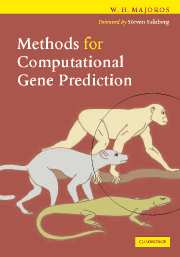Book contents
- Frontmatter
- Contents
- Foreword by Steven Salzberg
- Preface
- Acknowledgements
- 1 Introduction
- 2 Mathematical preliminaries
- 3 Overview of computational gene prediction
- 4 Gene finder evaluation
- 5 A toy exon finder
- 6 Hidden Markov models
- 7 Signal and content sensors
- 8 Generalized hidden Markov models
- 9 Comparative gene finding
- 10 Machine-learning methods
- 11 Tips and tricks
- 12 Advanced topics
- Appendix
- References
- Index
2 - Mathematical preliminaries
Published online by Cambridge University Press: 05 June 2012
- Frontmatter
- Contents
- Foreword by Steven Salzberg
- Preface
- Acknowledgements
- 1 Introduction
- 2 Mathematical preliminaries
- 3 Overview of computational gene prediction
- 4 Gene finder evaluation
- 5 A toy exon finder
- 6 Hidden Markov models
- 7 Signal and content sensors
- 8 Generalized hidden Markov models
- 9 Comparative gene finding
- 10 Machine-learning methods
- 11 Tips and tricks
- 12 Advanced topics
- Appendix
- References
- Index
Summary
In this chapter we will briefly review the basic mathematical machinery and notational conventions that it will be necessary to know in order to most effectively absorb the rest of the material in this book. It will be of use primarily to those lacking a strong computational background. We assume only that the reader has knowledge of algebra and has at least some minimal facility with a structured programming language. In section 2.4 we will summarize the syntax and semantics of the pseudocode which we will be using when describing algorithms, and which should be largely intuitive to anyone familiar with a modern programming language such as C/C++, Java, Perl, or Pascal.
The sections that follow will be, we believe, appropriately brief; readers requiring further elaboration of any of the topics in this chapter are encouraged to pursue the cited references. Conversely, readers with a strong computational background may skim this chapter, noting only the typographical conventions that we have opted to employ.
Numbers and functions
A number of standard constants and functions will be utilized in the chapters ahead. The two infinities, ∞ and -∞, should be familiar enough; we will use them to denote the largest and smallest values, respectively, that can be represented in a particular computer system. As computer architectures advance, these respective values may grow, and so it is advisable when writing a gene finder to use an appropriate portable means of referring to these values in source code.
- Type
- Chapter
- Information
- Methods for Computational Gene Prediction , pp. 28 - 82Publisher: Cambridge University PressPrint publication year: 2007



